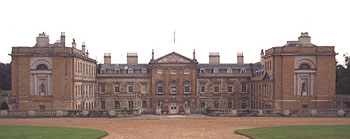Lord John Russell served as Prime Minister from 30 June 1846 to 21 February 1852 and from 29 October 1865 to 26 June 1866. He was born on 8 August 1792, the third son of the sixth Duke of Bedford. He was educated at Westminster School and the University of Edinburgh.
When he was fully grown, Russell stood only 5' 4¾" tall and weighed about 8 stones (112 lbs; 50 kg): his diminutive size was a constant source of surprise to others. In the 1830s, the witty Sydney Smith claimed tongue-in-cheek, “Before this Reform agitation commenced Lord John was over six feet high. But, engaged in looking after your interests, fighting the peers, the landlords, and the rest of your natural enemies, he has been so constantly kept in hot water that he is boiled down to the proportions in which you now behold him.”
Russell, who entered Parliament in 1813 as the MP for Tavistock, during the 1820s persistently advocated both extending the franchise and granting political equality to Roman Catholics. His support of parliamentary reform won the Whigs a great deal of support in the 1830 General Election although the Duke of Wellington formed the ministry which lasted only until November 1830.



Three editorial cartoons caricaturing Russell’s small stature from Punch. Click on images for captions and commentary.
Russell served as Paymaster General in Earl Grey's Whig ministry of 1830-1834 and was one of the four members of the government responsible for drafting the Reform Bill (1832), which doubled the British electorate. Russell proposed the legislation to parliament, and he was responsible for steering it through the House of Commons. On the third attempt to push the legislation through parliament, Russell was the only man who knew of the Bill's contents: he was still trying to dry the ink on the proposals when he entered the House of Commons. In November 1834 he resigned along with the Prime Minister, Lord Melbourne, and sat on the Opposition Front Bench during Peel's first ministry.

Woburn Abbey, country seat of the Dukes of Bedford.
Following Peel's downfall, thanks to the Lichfield House Compact, Russell rejoined Melbourne's government and served as Home Secretary from 1835 to 1839 and then as Secretary for War and the Colonies from 1839 to 1841. He was also Leader of the House of Commons during this time. In the General Election of 1841, which the Conservatives won, Russell was returned as MP for the City of London, which he represented until he was elevated to the House of Lords in 1861.



Three editorial cartoons caricaturing Russell’s small stature from Fun. Click on images for captions and commentary.
Immediately after the repeal of the Corn Laws Peel resigned and Russell became Prime Minister at the head of a Whig administration. During this first premiership (1846-1852), he helped pass legislation limiting working hours in factories in the 1847 Factory Act and was responsible for passing the Public Health Act of 1848. This ministry also ended restrictions on colonial trade by repealing the Navigation Acts in 1849.
His government's efforts to prevent widespread starvation as a result of the Irish famine of 1846-1847 were ineffective. Russell's alternate support for and dissent from Aberdeen's government policies during the Crimean War (1854-46) caused him to lose the leadership of the Liberal party to Viscount Palmerston.
As foreign secretary (1859-1865) under Palmerston, he supported Italian Unification and antagonised the United States during the American Civil War by actions that seemed to favour the Confederacy. He retired from political office after briefly heading a second ministry in 1865-1866 but continued to sit in the House of Lords where he spoke on a variety of issues until he died on 28 May 1878.
Related Material & Political cartoons featuring Russell
- Russell’s translation of Dante’s description of Paolo and Francesca in the Inferno
- The Political Patroclus putting on the Armour of Achilles
- Sons of Harmony
- The Last Pantomime of the Season
- A Lesson in Dip-lomacy
- The Belle of the Session
- Itching Johnny
- A Government Conveyance
- In Training for St. Stephen’s
- Britannia’s Valentine
Recommended reading
Prest, J. Lord John Russell. London, 1972.
Walpole, S. The Life of Lord John Russell. 2 vols., London, 1889.
Created 2002
Links last added 20 May 2019

